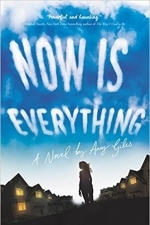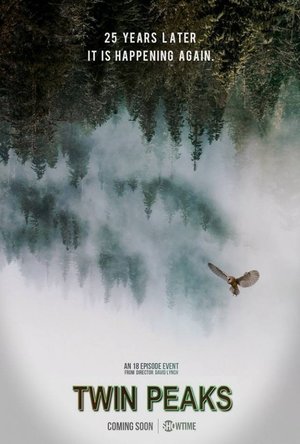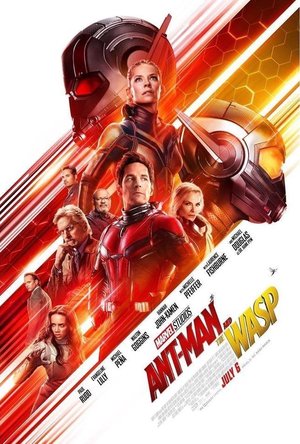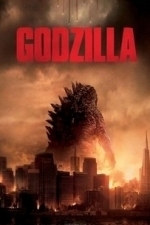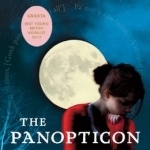
Calorie Counter Pal: Carbs Steps & Fitness Tracker
Health & Fitness and Medical
App
Please e-mail at admin@healthgoal360.com, if you have a question or difficulty using the app. ...

Natural Cycles, Birth Control
Health & Fitness and Medical
App
Natural Cycles helps you keep track of your ovulation, period and fertility. The app will show you...

Baby Monitor 3G
Lifestyle and Health & Fitness
App
The First HD quality multiplatform Baby Monitor is here! BABY MONITOR 3G is a universal video and...
Kristy H (1252 KP) rated Now Is Everything in Books
Dec 24, 2017
This book. Oh this book. Wow. I completely overlooked this one on my ARC shelf, and for that, I deeply apologize. But, I'm so, so, so glad I did pick it up! This is an amazing, powerful, and heartbreaking book and easily one of my favorite books I've read this year.
Part of the power comes via its format, which seems simple on the surface. The novel and its details are all a slow build via a "then" and "now" format plus transcripts and bits of evidence from the crash investigator. All of our "then" and "now" portions come from Hadley's point of view and leave us constantly wondering. Why is her dad all over her? What makes him so evil? You are also left in utter confusion and suspense over exactly what happened during the crash (and why it happened). I read the second half in one sitting, staying up late to finish it. I simply had to know what happened to Hadley.
I credit this to Giles' writing, which is superb. You will get sucked in by Hadley extremely early. She's a well-written, compelling character, and it's nearly impossible not to become part of her life. In fact, rarely have I felt so strongly for characters in a novel in a long time. If I could have, I would have gone and rescued those children myself! I simply loved Hadley and her wonderful, feisty sister, Lila. The hate I felt for their horrible, abusive father--and, sometimes, their apathetic, passive mother, was insane. They felt like real people. I was completely involved.
In fact, those poor kids. The book actually made me feel tense just reading about their lives. It was so well-done that I read portions of it with a knot in my stomach. (As a note, there's definitely a trigger for abuse.) Watching Hadley try to protect her sister and live up to adult expectations far beyond her teen years--seriously, guys, it was heartbreaking and yet amazing to read. You will find yourself rooting for Hadley and Lila in an inexplicable way.
The ending on this one is interesting. I'm still pondering it. The fascinating thing about this book is that you know *something* has to have happened up in that plane, but you don't know exactly what, or how it all goes down. The ending made me go "wow." I'm not exactly sure it's what I would have chosen, but it still felt right somehow. Although I was so attached to Hadley, that I wish there was a sequel of sorts, because I still feel bonded to the girl. That's how well-done this novel was!
Overall, this is just a lovely book. Very, very rarely does a book make me cry. This one did. This is not a light read, no, but there are still funny moments, beautiful moments, and heartwarming moments among all the dark ones. You will not regret reading this book. Huge kudos to Amy Giles for writing such a powerful and wonderful novel that so deftly deals with abuse and aspects of mental illness. I feel like Hadley and Lila will stay with me for a long time. 4.5 stars.
theVman (16 KP) rated Twin Peaks - Season 3 in TV
May 22, 2017
*** Ive tried to write this as spoiler free as i can, you may find some in here but nothing that i think would ruin watching the show for you ***
I don’t think it will come to anyones surprise to say that the first four episodes of Twin Peaks return are strange. But maybe not in the way that we know and love.
I found these first four episodes difficult to enjoy not because they were bad, but because it was not what I was expecting at all. I wanted the key things that I love about Twin Peaks to be there, the returning characters, the iconic score by Angleo Badalamenti, the quirky weirdness grounded by soap opera like stories. I wanted the dark seriousness of murder, lust and money, beautifully intertwined with the ridiculousness of silent drape runners, saving the pine weasel and miss twin peaks contests.Unfortunately I found very little of any of what I wanted.
Yes Cooper is back or more accurately Kyle Maclachlan is back but has yet to act or sound anything like Special Agent Dale Cooper at all, the story calling for him to play a very lifeless rendition of his former glory. Other familiar faces have shown up along the way, but not very many and for not very long at all.
What we have is something very Lynchian, long drawn out scenes, especially in The Black Lodge that after extended moments of a droning humming score and lot of not a lot going on in slow motion followed by more not a lot going on but this time with a white horse or a talking lump of flesh on a leafless tree in the picture, it starts to feel like a lot of weird stuff just for sheer sake of being weird.
Fans of the previous seasons of Twin Peaks might be left wondering what is going on with the stories that were left open, is Leo still holding that rope in his mouth, what happened after the explosion in the bank vault, and what the hell has happened to Annie – well you wont find any of these answers here. Instead we are given a whole bunch of new characters, who’s stories we are still trying to figure out and how they are related to the events of Twin Peaks, which is a made into a bigger and more confusing mystery seeing as none of them actually take place in Twin Peaks at all. In fact, the most recognisable place in the first few hours is The Black Lodge, which features extensively in the first two episodes before “Cooper” bizarrely ends up in Las Vegas. Also knocking us out of our comfort zone and driving home the fact that this is not the same kind of Twin Peaks show we are used to, are the occasional F bombs being dropped and the coy sexiness that flowed through the show has been replaced with plain nudity.
We have been given vision that is pure David Lynch. He produces some fantastical imagery and some unnerving editing that is like watching Eraserhead, Lost Highway and Fire Walk With Me all at the same time on the same screen. As a piece of art it has its place amongst Lynch fans, but as a piece of entertainment for prime time television, it missed the mark for me, and as a return to Twin Peaks, it should be ashamed of itself, as apart from 30 seconds or so in episode 4 where here the familiar twangs of the original score, I didn’t feel like there was any return to that great tv show from the early 90s. There is the odd nugget of new that will keep me watching, Naomi Watts and Matthew Lillard have joined the team in what promises to be entertaining roles, there is a glass box that is being kept in some kind of secret bunker under constant video monitoring that seems to have something to do with The Black Lodge, the log lady is getting message from her log again, a body that doesn’t belong to its head and we are still hanging out at the Bang Bang Bar with Bobby, Shelley and James even if it was for far too brief at time.
Overall: It didn’t deliver on its promise, or give me what I wanted, but there is still a lot more episodes to come. I cant think of another show that would get away with such a slow build or lack of deliverance than the new third season of Twin Peaks.

Sony AX53 4K Handycam Camcorder
Tech Watch
The Sony AX53 4K Handycam is a powerful, feature-packed 4K Camcorder with Sony's Exmor R™ CMOS...
Bob Mann (459 KP) rated Ant-Man and the Wasp (2018) in Movies
Sep 28, 2021
But, let’s turn from big things to small things. In a prologue we see a young Dr Hank Pym (Michael Douglas) and wife Janet (Michelle Pfeiffer) torn apart as Janet miniturises herself into the “quantum realm” to save the world from nuclear disaster. But in the present day Hank thinks there might be a way to find and retrieve Janet with the help of their superhero daughter Hope (“The Wasp”, played by Evangeline Lilly). (“What the f*** have you been thinking about instead for the last 30 years while I’ve been sat here avoiding neutrons”, would be the imagined response from Janet, but we don’t go there!).
But Scott Lang (aka “Ant Man”, Paul Rudd), having also been to the quantum realm, holds a key part of the puzzle. To add to their problems, a strange ghost-like girl called Ava has her own reasons for retrieving the lost soul, but in ways that will tear Janet limb from limb. Can Hank, Hope and Scott succeed, while dodging both The Ghost, the FBI and other criminal forces intent on seizing Pym’s technology?
I must admit that I’d somewhat forgotten how “Ant Man” ended three years ago, which together with the one film missing from my Marvel-watching canon being “Captain America: Civil War” left me somewhat confused by why we start the film with our hero Lang under two-year’s house arrest. But much fun is had with Lang’s curfew and the frustration of FBI agent Jimmy Woo (Randall Park) in trying to catch him breaking the rules.
For we are again at the comedic end of the Marvel universe. However the comedy is extremely uneven this time and doesn’t sit particularly well with the dramatic and emotional elements of the film. It’s certainly nowhere near the consistently funny content of the surprisingly good “Thor: Ragnarok”. Some of Rudd’s lines just smell of “trying too hard”.
Adding comedic value is Michael Peña returning here as Scott’s partner Luis. His motor-mouth routine after taking a truth drug (“not a truth drug”!) was hilarious, with the rest of the cast miming his words in flashback.
It has to be said though that there are some truly great sight-gags, to rival the Thomas the Tank Engine scenes in the first film. The expanding salt-cellar; the expanding / contracting car and building moments; and the “skateboard” scenes. But all – and I mean ALL – of these scenes were universally spoiled by the trailer, such that the reaction to them was “oh, that’s that bit then”. NEVER has there been a better case for a teaser trailer that basically said “Ant Man’s back; here’s ONE wow-factor visual”. It’s just criminal. Interestingly, re the trailer, there was also at least one scene (the “you go high, I’ll go low” one, which I thought was very funny) that didn’t make the cut I saw.
Acting wise you can’t fault the cast with Lilly just great as “The Wasp”. If I was her, I would have said “OK… I’ll do the film, but I get to keep the suit!”. That would be her age monitoring device for years to come…. “Does the zip still do up at the back? Do my impossibly pert breasts still align with these impossibly well-moulded contours?”. It’s also great to see Michael Douglas and Laurence Fishburne going head-to-head in the acting stakes. Walton Goggins again crops up as a believable bad-guy, a performance I really enjoyed, but the star turn for me in the whole film was a career-making performance by Hannah John-Kamen as Ava/The Ghost: she’s previously only had small supporting roles in “Tomb Raider” and “Ready Player One”. Looking like a Star Wars sand-person in her outfit she removes her mask to reveal a stunningly piercing gaze and great screen presence. One to watch for the future.
Directed by original “Ant Man” director Peyton Reed, it’s a perfectly entertaining watch for a summer night, but it is uneven in tone, perhaps the result of the team of five credited with the writing. Ask me in two months’ time to tell you anything about it and I will probably struggle. It’s a “meh” sort of film for me.
Ryan Hill (152 KP) rated Godzilla (2014) in Movies
Jun 28, 2019
The first thing to mention about this film is its cast and its focus on the human characters, played mainly by Aaron Taylor-Johnson (Lieutenant Ford Brody), Elizabeth Olsen (Elle Brody, Ford's wife), and Bryan Cranston (Joe Brody, Ford's estranged father). Bryan Cranston is only really in the first half, portraying his character as a very outcast, yet very determined former nuclear engineer who is searching for the truth about his wife's tragic death. He was fantastic in the role delivering each line with emotion and conviction he was the best character in the film and I wish he was in the film longer. His theories beautifully foreshadow the events to come, and he drags his son, Ford, right into the heart of the trouble. Thankfully, this means that we get to see lots of the brilliant Aaron Taylor- Johnson, a courageous explosive ordnance disposal technician who comes face-to-face with Godzilla several times. Literally. Aaron Taylor-Johnson really is the star here, and the scenes with his wife, Elle, and son, Sam, before any of the action starts makes his actions later on all the more respectable and courageous as he risks his life to save them and the entire city. Elizabeth Olsen isn't used as much as I would have liked, as she is fantastic in the scenes in which we see her. Having said that, she does appear a fair amount, as the strong wife and mother holding back her terror in order to stay and help. Her scenes with Aaron Taylor- Johnson are great too, and make for some very believable characters. The other main character is Dr Serizawa (played by Ken Watanabe), a scientist monitoring Godzilla and the MUTOs. He doesn't really do much apart from look very worried in every shot and say tense or shocking one-liners, but Ken Watanabe makes sure that it's never cringe-worthy or boring.
Secondly we have Gareth Edwards' directing - wow! I need to see more of this guy! Every shot looks as good as it could possibly be, and the first reveal of Godzilla is brilliant. There's a MUTO smashing up an airport. Cue plane exploding, followed by the one to the right, and then the one to the right, and then… a foot. Silence. Another foot. Cut to a shot of the MUTO roaring, and then back to the feet. Up the camera pans (for quite a long time!), leaving us with a beautiful high-angle shot of the beast himself. And then comes the roar. There's another great shot of Godzilla making his way across the Pacific to San Francisco, and another in the city itself of… well, there's no other way of putting it – Godzilla and a MUTO having a good old' fashioned fistfight, which culminates in a pretty fantastic and well-timed tail slam from the big guy. The skyscrapers don't really bother them. It's just a long shot, and in it we see two giant monsters ripping each other to shreds and obliviously destroying the city below. Another great shot (or shots) is during the HALO jump, as we see the city in flames, the men falling through the clouds and the burning skyline and a close-up of a Godzilla vs MUTO fight.
Now I'll move on to the plot and the headline acts – the MUTOs and the big guy himself, Godzilla. The plot is very straightforward. A MUTO hatches in Japan, one hatches in Nevada next to Las Vegas, and this is all because they've been feeding on humanity's nuclear waste and radiation. Oh, and by the way, the MUTOs look brilliant. Imagine a metal praying mantis crossed with a four-legged spider, as tall as a skyscraper. That's a MUTO. Anyway, Ford joins the fight to stop the creatures, and as they make their way to San Francisco the military plan to destroy them with their most powerful nuclear weapon. Godzilla is closing in too, and when the pesky MUTOs steal the nuke and build their nest around it, Ford and a group of soldiers must go into the city to detonate it. However, Godzilla and the MUTOs are also in the city, smashing everything (including each other) to bits. It's very odd that, for once, we end up cheering Godzilla on, as the two MUTOs begin to overwhelm him as he is seemingly hurt. And then he is actually made out to be the good guy (a twist I enjoyed), as he saves Ford in a spectacular way from a MUTO and the media call him " the saviour of our city?". 'Zilla looks amazing too. "Massive" is probably an understatement, but the spikes on his back, the battle scars on his body and his terrifying face make him look awesome. Also, his roar had me jumping up and down with excitement, as did his surprise for the MUTOs: his atomic fire breath.
All in all, "Godzilla" is one fantastic movie. No longer a mockery, but terrifying, tense, and, unlike many monster movies, it is complex. Complex in that it has multiple characters with interesting back-stories (that are all explored) and gives Godzilla a new personality and purpose. Everything looks great, it feels epic, and I enjoyed every moment. This is a movie that would appeal to anyone.
Eilidh G Clark (177 KP) rated The Panopticon in Books
May 13, 2017
At the beginning of the novel, the fifteen-year old Anais is governed by the state. In contemporary British society, a child under the age of sixteen, regardless of her social situation is, by law, governed by an adult/s. Anais has lived her life in the care system with the exception of a short period in which she lived with an adopted mother. It is for this reason that she is able to see society from outside of the family unit. By creating the motherless child, Fagan presents Anais as the ‘other’ from both a societal perspective- ‘communities dinnae like no-ones,’ and from the viewpoint of the protagonist, ‘What they really want is me dead,’ (TP, p.23). Without a family, and through a lack of legitimate information regarding her birth mother, Anais believes that she was created in a lab:
I’M AN experiment. I always have been, It’s a given, a liberty, a fact. They watch me. Not just in school or social-work reviews, courts or police cells – they watch everywhere. […] They’re there when I stare too long or too clearly, without flinching. […] They watch me, I know it, and I can’t find anywhere any more – where they can’t see, (TP, Prologue).
Note that in the above quotation, the protagonist describes her assumed identity as a ‘liberty’. Liberty, in this case, means freedom from the oppressive nature of the family. Although Anais desires the nurturing aspect of the family, ‘I just want my mum,’ (Tp, p.269), her lack of family exposes her to the nature of contemporary society as a constant monitoring of civilians. In the above quotation, the repetition of ‘they’ suggests that she feels outside of the norm. The most important aspect of the above quote however, is that it is told from the protagonist’s thoughts. While Fagan gives Anais a certain amount of autonomy through both the first-person narrator, and the vernacular, the reliability of the narrator is increased by presenting the characters inner thoughts. While this limited autonomy is important, full autonomy is restricted by age. Bever suggests that ‘the capacity for individuals to become autonomous seems radically dependent on the contingent historical circumstances and societies into which they are born. Anais’ awareness of herself as the ‘other’ allows her an insight into the oppressive role of society, which is normally hindered in childhood due to the role of the family and it’s teaching of norms and values.
The sense of otherness can also be looked at in regard to Scotland and its role within the UK. The UK is a family of four countries under one state. Regardless of Scotland’s devolution, it has still to comply with a large amount of UK policies. Scotland has different values and goals to that of the UK making it ‘other’. With a different cultural identity to its neighbours, many Scottish citizens are seeking independence to protect its dwindling identity, whilst for others, independence is political.
Anais’ awareness of social control causes her a feeling of shrinking. This, according to her social workers is an identity problem:
Fifty odd moves, three different names, born in a nuthouse to a nobody that was never seen again. Identity problem? I dinnae have an identity problem – I dinnae have an identity, (TP, p.99).
Anais’ reaction in the above statement describes her lack of knowledge of her ancestry. I would argue that her identity is forced upon her from the fifty-one times that she has moved home, the care system, the solitary time in which she was adopted, the relationships she has had - both female and male, her friends but more importantly, from the unreliable account of her birth from the monk in the metal institution. The lack of family does not alter the fact that she is alive, and that all the fragments of her past make up an identity. For Anais, ‘Families are overrated […] ‘I umnay fooled. Not by families,’(TP, p.63-64). Like Anais, Scotland’s identity is ambiguous. Independence will allow Scotland political autonomy, however, within a global economy, Scotland still has limited autonomy. As culturally ‘other’ however, Scotland has already achieved autonomy with or without a state through its language, its people and its traditions.
Fagan demonstrates the difficulty of total autonomy though Anais and the birthday game, a game in which she creates her own identity. When she turns sixteen years of age, Anais is free from societal care and flees from her imprisonment, ‘I am Frances Jones from Paris. I am not a face on a missing-person poster, I am not a number or a statistic in a file. I have no-one watching me, […] I−begin today,’ (TP, p.323-324). ‘I’ suggests singularity and is still opposite to ‘them’ or ‘we’. Autonomy is therefore, ambiguous; Anais is still living within the same system under a false identity, she is therefore, segregated from everyone that she knows. Moreover, by changing Anais’ name to a name that ‘means freedom.’ (TP, p.323), Fagan is pointing out the difference between freedom and autonomy. Freedom is an emotive word, and there are two concepts of freedom – freedom from, which in Anais’ situation means freedom from the system of observation. Freedom to, however, is more problematic as Anais can never be free from the neoliberal system of rules and law – as Scotland would see in the case of independence. I would therefore conclude that Anais/Scotland has always has limited autonomy through cultural identity and history. I believe autonomy can only reside within the system through cultural and individual imagination and not out with it.
What does this mean for Scotland? If Scotland is part of the global community, can it become an autonomous nation? Is there a solution or should Anais/Scotland accept that cultural autonomy is imagined or self-contained. Can a collective identity and imagination change the political system? Finally, can culture survive without independence?
Bibliography
Crupp, Tyler, ‘Autonomy and Contemporary Political Theory’, in Encyclopaedia of Political Theory, ed. Mark Bevor (London: Sage Publications, 2010)
Fagan, Jenni, The Panopticon (London: Windmill Books, 2013), p.6.
Windmill Books. (2013). Granta Best Young British Novelist Jenni Fagan, . accessed 22 November 2015. Published on Apr 16, 2013

Locator365 – Remote Mobile Tracking, Routing Record. Prevent Missing Persons
Navigation and Productivity
App
【Video Demo】 http://www.youtube.com/watch?v=D7Hz3EKnQiA 【AppPicker.com Review*****】 - If...
